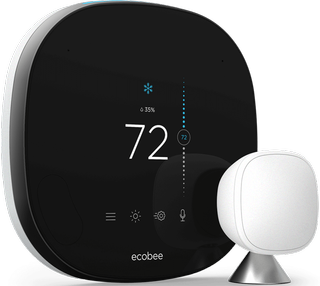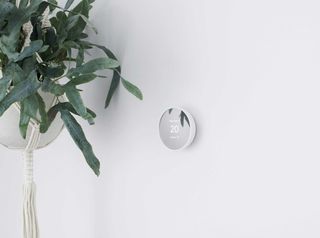Nest Thermostat vs. Ecobee SmartThermostat: Which should you buy?

Ecobee SmartThermostat

The Ecobee SmartThermostat with voice control is intelligent in all the right ways. It suggests ways to reduce your energy bill, works with virtually all smart homes and smart speakers, supports room sensors for temperatures throughout the house, and can even take voice commands itself.
Ecobee SmartThermostat
Doubles as a smart speaker
Nest Thermostat

The Google Nest Thermostat 2020 removes the automated learning tech and sensors of its predecessor in favor of intelligent suggestions, HVAC monitoring, and a new side touch strip. It's much less expensive than most smart thermostats and knows when to turn off the heat while you're away from home.
Nest Thermostat
Multicolor mirrored lenses
People shopping for a smart thermostat in 2020 still have only two main options worth considering: a Nest thermostat versus an Ecobee thermostat. Both remain unparalleled in energy savings and smarts, but Ecobee hasn't released a new thermostat since the 5th Gen Ecobee SmartThermostat with Voice Control in mid-2019, while Nest has shaken things up with a brand-new, bargain-priced Nest Thermostat. Both will cut down on your energy bill, so we'll help you decide if the more intelligent Ecobee model is worth the extra money.
Nest Thermostat vs Ecobee Smart Thermostat: Smart features and smart sensors
Unlike the Nest Learning Thermostat, neither the new Nest Thermostat nor the Ecobee SmartThermostat can automatically generate a heating and cooling schedule based on your habits. You'll have to build your own custom schedule in each device's app. Yet both thermostats do have various intelligent learning tools for improving your energy efficiency.
We'll start with what both devices can do. Either thermostat will detect when you've left home and automatically turn down your HVAC energy use. Each device's app has a scheduling tool for pre-planning dips and rises in energy usage that you'll build yourself. After that, you'll receive suggestions from both apps telling you which parts of your schedule could be improved — though you can always choose to ignore these suggestions for the sake of comfort.
That mostly sums up what the Nest Thermostat can do, with one important exception: it now features HVAC monitoring, meaning it will track how quickly your system will heat or cool your home and warn you if your system appears to be getting less effective.
Ecobee will automatically avoid peak energy usage to save you money, precooling or preheating your house when it won't cost as much.
Ecobee's thermostat has more to offer, thanks to its free Eco+ upgrade. For starters, it has a Time of Use feature that takes into account local surge pricing on electricity: If it gets more expensive at 3 p.m., your Ecobee will preemptively cool down your home before 3 p.m., then use less energy once the price goes up. Similarly, you can sign up for Community Energy Savings, which will detect when your local power grid is under strain and reduce your energy usage accordingly. It also has a Feels Like function that takes humidity into account when adjusting your home temperature.
Be an expert in 5 minutes
Get the latest news from Android Central, your trusted companion in the world of Android
You get a clearer picture of your home's actual temperature with an Ecobee SmartThermostat. Unlike the Nest Thermostat, which can only sense the temperature nearby itself, your Ecobee will ship with a SmartSensor in the box that you can place in another room in the house for a clearer reading. Plus, you can buy an extra two-pack for $65 that will spread its gaze even further.
Sensor support is why we rated the Ecobee SmartThermostat as the best smart thermostat for multiple zones, and why it's disappointing that the new Nest Thermostat dropped support for its smart sensors that work with the Nest Learning and E Thermostats.
Nest Thermostat vs Ecobee Smart Thermostat: Do you need another smart speaker?

There's a reason why, at full price, the Ecobee SmartThermostat is nearly double that of the Nest Thermostat: It's a smart thermostat and an Alexa smart speaker bundled into one four-inch device. In our sibling site iMore's review of the SmartThermostat, they described the far-field microphones as "surprisingly effective, picking up Alexa commands from lengthy distances, and the speaker, while not the greatest quality, is enough to deliver easily identifiable responses."
The Ecobee SmartThermostat has a 1.5GHz quad-core CPU with 4GB of flash memory that makes it quick to handle your queries or perform other tasks. It has an LED strip that glows blue when listening to your commands and red when the microphone is turned off. It can even play your Spotify playlists through the speakers!
Ecobee's built-in Alexa is an excellent feature, but consider whether you need a speaker wherever your HVAC wires are located.
Your question should be whether you need any of these features, and it mainly depends upon where you'll be installing this device. Is your current thermostat in a hallway where it would be awkward to stand and ask for a weather forecast or listen to music? Or is it in the living room, where you already own an Alexa speaker? You could certainly purchase a Nest Thermostat and Echo 4th Gen smart speaker for around the same price as the Ecobee and get better audio quality.
You shouldn't necessarily avoid buying the Ecobee SmartThermostat if you don't need an Alexa-compatible thermostat. It also works with Google Home, Apple HomeKit, and IFTTT commands, so it should link up with whichever smart home you prefer.
But if you don't need mics in your thermostat, you could consider the Nest Thermostat or Ecobee3 Lite instead — both of which work with Amazon and Google smart speakers for a lower price. For example, we like how the Nest Thermostat can be controlled by our other Google Assistant speakers or smart displays using Google Home Routines, such as setting a specific temperature when you say "Good morning", "I'm home", or "Good night".
Nest Thermostat vs Ecobee Smart Thermostat: Installation and compatibility

The simplest reason to choose the Nest Thermostat versus the Ecobee SmartThermostat is if your HVAC system is only compatible with one or the other. Check the Nest compatibility checker and Ecobee compatibility checker to be sure before you buy either. Anyone with a high-voltage system (110, 120 or 240 volts) won't be able to install any Nest or Ecobee thermostat.
Check the Nest and Ecobee compatibility checkers before purchasing either thermostat.
Neither smart thermostat requires a C wire to work, which isn't the case with plenty of thermostats. With Ecobee, this is because the thermostat ships with a power extender kit (PEK) that essentially takes the place of a C wire during installation. With Nest, this is because the thermostat was designed to use less than 1 kWh/month, so it shouldn't even need the C wire as a primary power source.
Installing both devices should be completely straightforward. iMore's reviewer was able to install the Ecobee in 20 minutes by following along with the in-app instructions, while the Nest Thermostat also has app instructions that aren't supposed to take more than a half-hour to follow.
Our only concern is that many users have reported incessant problems with the Nest Learning Thermostat without a C Wire, such as strange clicking or thumping noises or other errors. We're uncertain as of yet whether those problems will persist with the new Nest Thermostat.
Nest Thermostat vs Ecobee Smart Thermostat: Display, controls, and specs
Voice commands and app controls aside, you'll often simply walk up to your thermostat and change the temperature. So consider what kind of touch command you'd prefer to accomplish this.
With the new Nest Thermostat, it has a touch strip on the right side of the thermostat; you slide your finger up and down to rotate through your choices and then tap your finger to select something. As for the Ecobee SmartThermostat, it features a traditional touchscreen.
Aside from being a touchscreen, the Ecobee display also has more pixels (320 x 480) than the Nest (240 x 320), though part of this stems from the Ecobee being an inch longer in diameter. It is also a full-color display, though by default it will be black. That differs from the Nest Thermostat, which has a mirrored IPS lens that comes in a few vibrant color options.
For all of the other differing information about these two smart thermostats, you can check our detailed spec table below:
| Header Cell - Column 0 | Nest Thermostat | Ecobee SmartThermostat |
|---|---|---|
| Price | $130 | $199 |
| Dimensions | 3.3"x1.1" | 4.29"x1" |
| Colors | Snow, Sand, Fog, Charcoal | Black front with white sides |
| Trim Plate | Sold separately | Included with purchase |
| HVAC Compatibility | 85% of systems Most 24V heating and cooling systems | Gas, Oil, Electric, Dual-fuel Conventional (2H/2C) Heat Pump (4H/2C) Humidifier, Dehumidifier, Ventilator, HRV or ERV |
| Display | 2.4-inch IPS LCD with mirrored lens 240x320 pixels | 3.5 in. full-color LCD touchscreen 320x480 pixels |
| Energy Star Certified | Yes | Yes |
| Built-in sensors | Motion Temperature Humidity Capacitive touch Ambient light | Temperature Humidity Proximity Occupancy |
| Remote temperature sensors | No | Yes |
| Manual temperature changes | Touch strip on side | Touch screen |
| Recommends schedule adjustments | Yes | Yes |
| App connectivity | Google Home | Ecobee |
| Smart Home connectivity | Alexa & Google Assistant | Apple HomeKit, Amazon Alexa, Google Home, Samsung SmartThings, IFTTT |
| Power | Various HVAC system wires, 2 AAA battery backup | Wired 24VAC through terminals C and Rc; Power Extender Kit |
| Wi-Fi | 802.11b/g/n 2.4 GHz, 802.11a/n 5 GHz Wi-Fi | 802.11 b/g/n @ 2.4GHz, 802.11 a/n/ac @ 5GHz |
Nest Thermostat vs Ecobee Smart Thermostat: Which should you buy?

Whichever smart thermostat you decide to buy, you'll start saving money instantly on your energy bill. You can install either thermostat yourself in less than an hour, and each device has AI algorithms for determining all the areas where you're wasting money. Both have useful automated tools, though the Eco+ suite of features are particularly advanced. Ecobee is more expensive, but you may be able to snag one for a major holiday discount.
Who should pick the Ecobee SmartThermostat? People with large homes who want specific room temperature data; fans of smart speakers and Alexa in particular, who don't already have a smart speaker in the same room as the thermostat; or anyone who regularly uses IFTTT applets or Apple HomeKit.
Who should pick the Nest Thermostat? Anyone on a budget; those who want a more stylish thermostat to add a splash of color on their wall; owners of older homes that are worried about their HVAC health; or people concerned about privacy, who don't like any device with a built-in mic in their home.

Eco+ smart savings
For a high-quality thermostat that has built-in voice controls, intelligent temperature shifts based on relative energy costs during the day, and a reliable LCD touchscreen, stick with Ecobee's flagship thermostat.

Works with Alexa and Google Assistant
For a new device that won't break your budget and will look stylish on your wall, the Nest Thermostat is a solid buy. It will poke and prod you into saving money on your energy bill, safeguard your HVAC system and automatically track when everyone leaves home.

Michael is Android Central's resident expert on fitness tech and wearables, with an enthusiast's love of VR tech on the side. After years freelancing for Techradar, Wareable, Windows Central, Digital Trends, and other sites on a variety of tech topics, AC has given him the chance to really dive into the topics he's passionate about. He's also a semi-reformed Apple-to-Android user who loves D&D, Star Wars, and Lord of the Rings.
For wearables, Michael has tested dozens of smartwatches from Garmin, Fitbit, Samsung, Apple, COROS, Polar, Amazfit, and other brands, and will always focus on recommending the best product over the best brand. He's also completed marathons like NYC, SF, Marine Corps, Big Sur, and California International — though he's still trying to break that 4-hour barrier.
